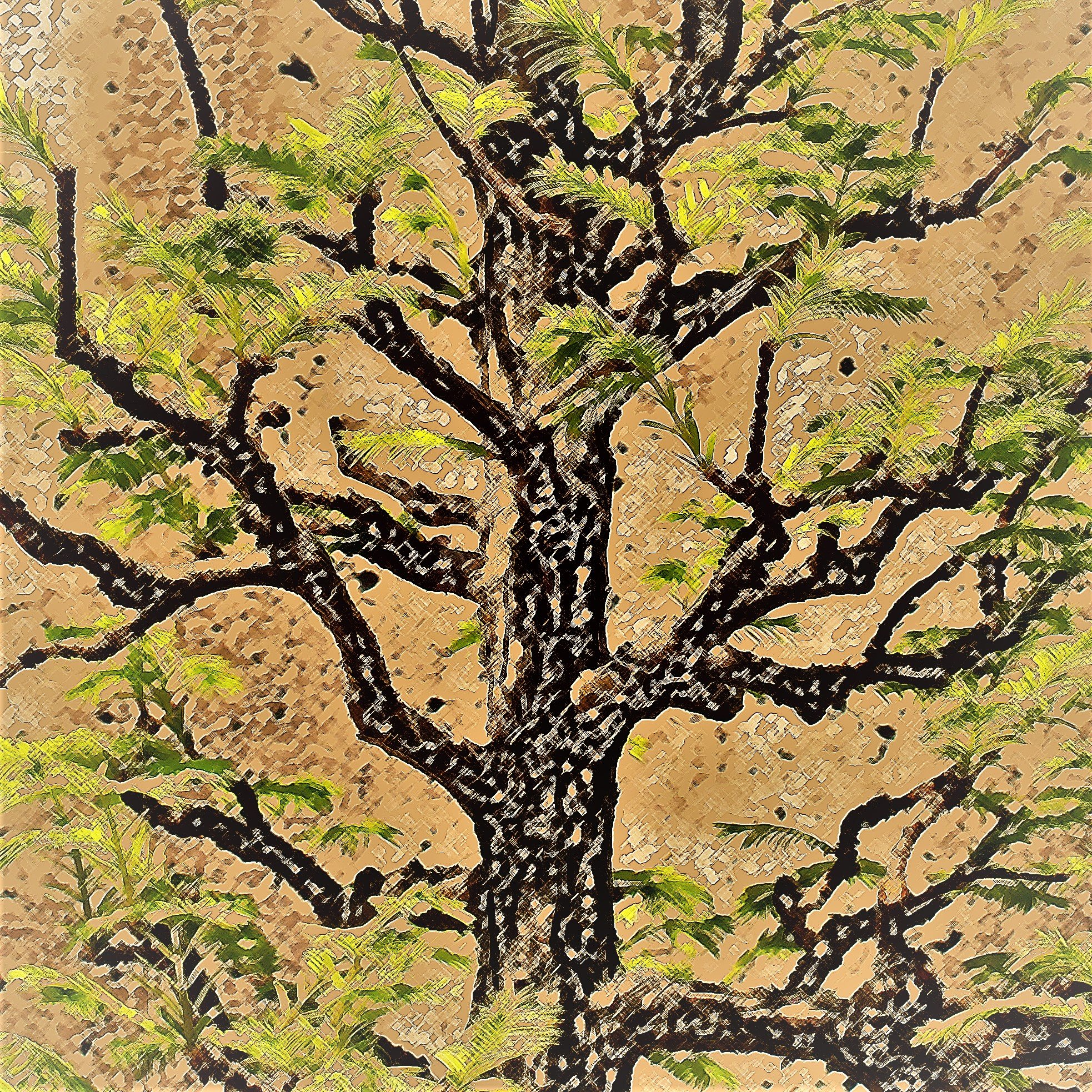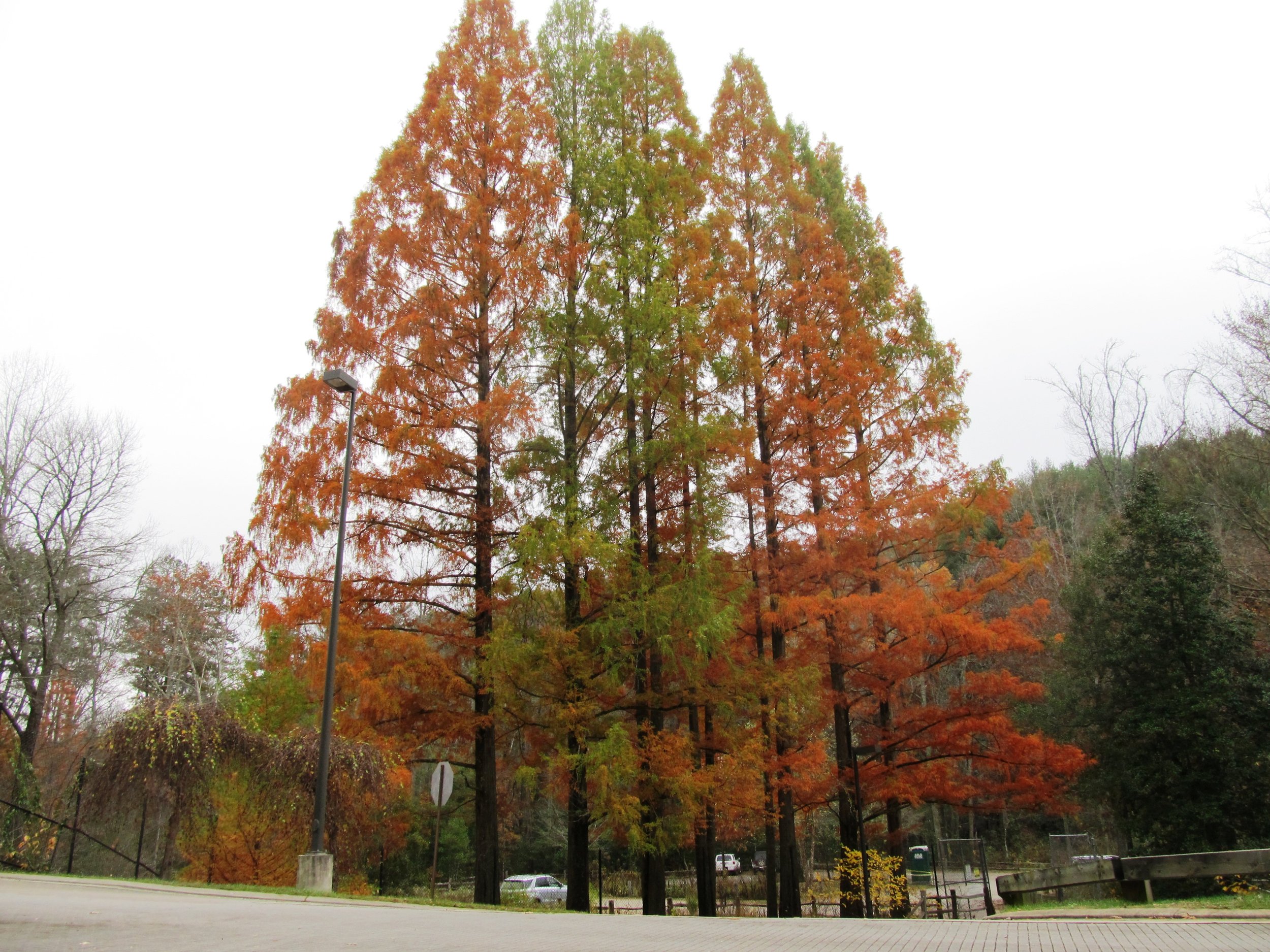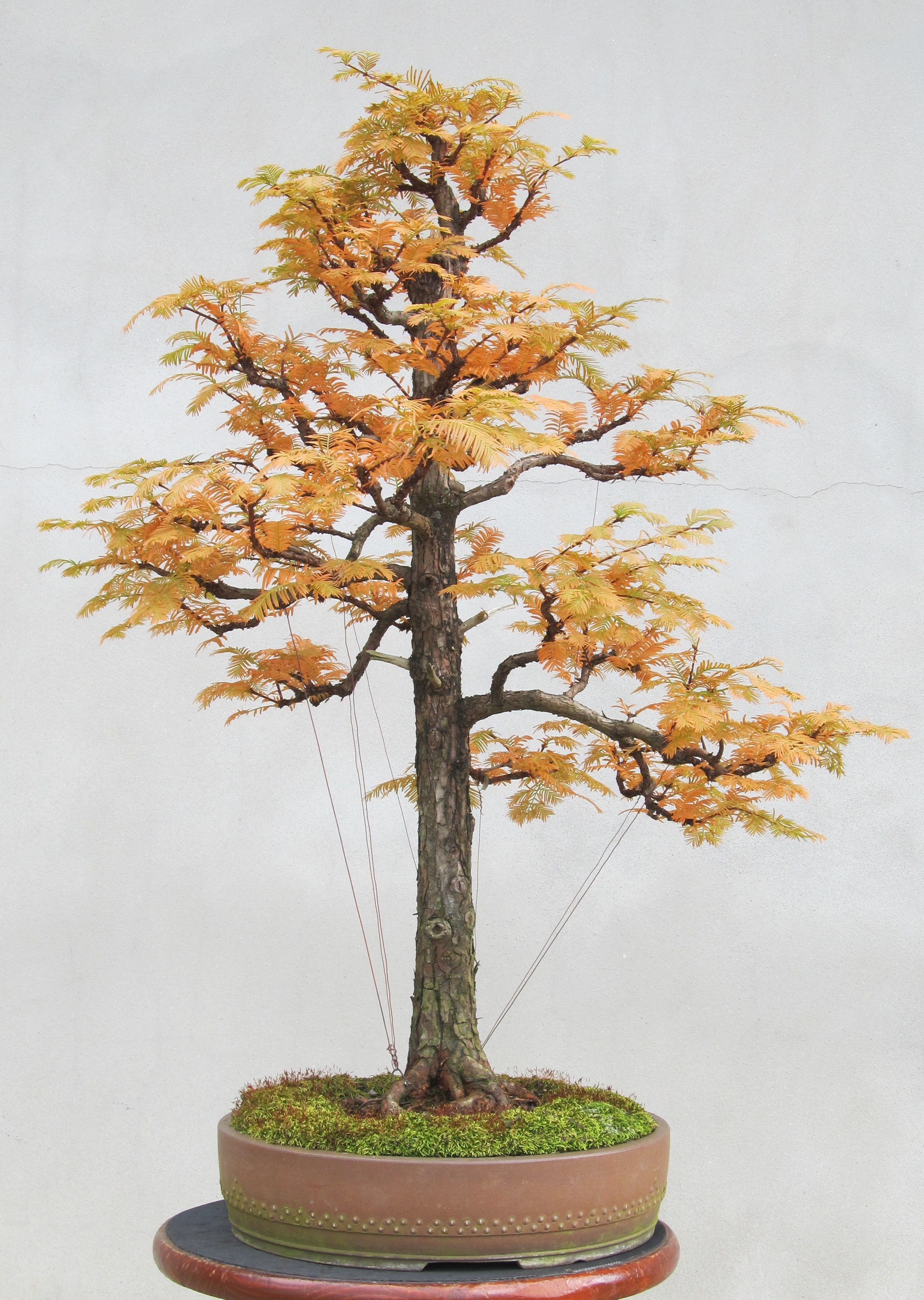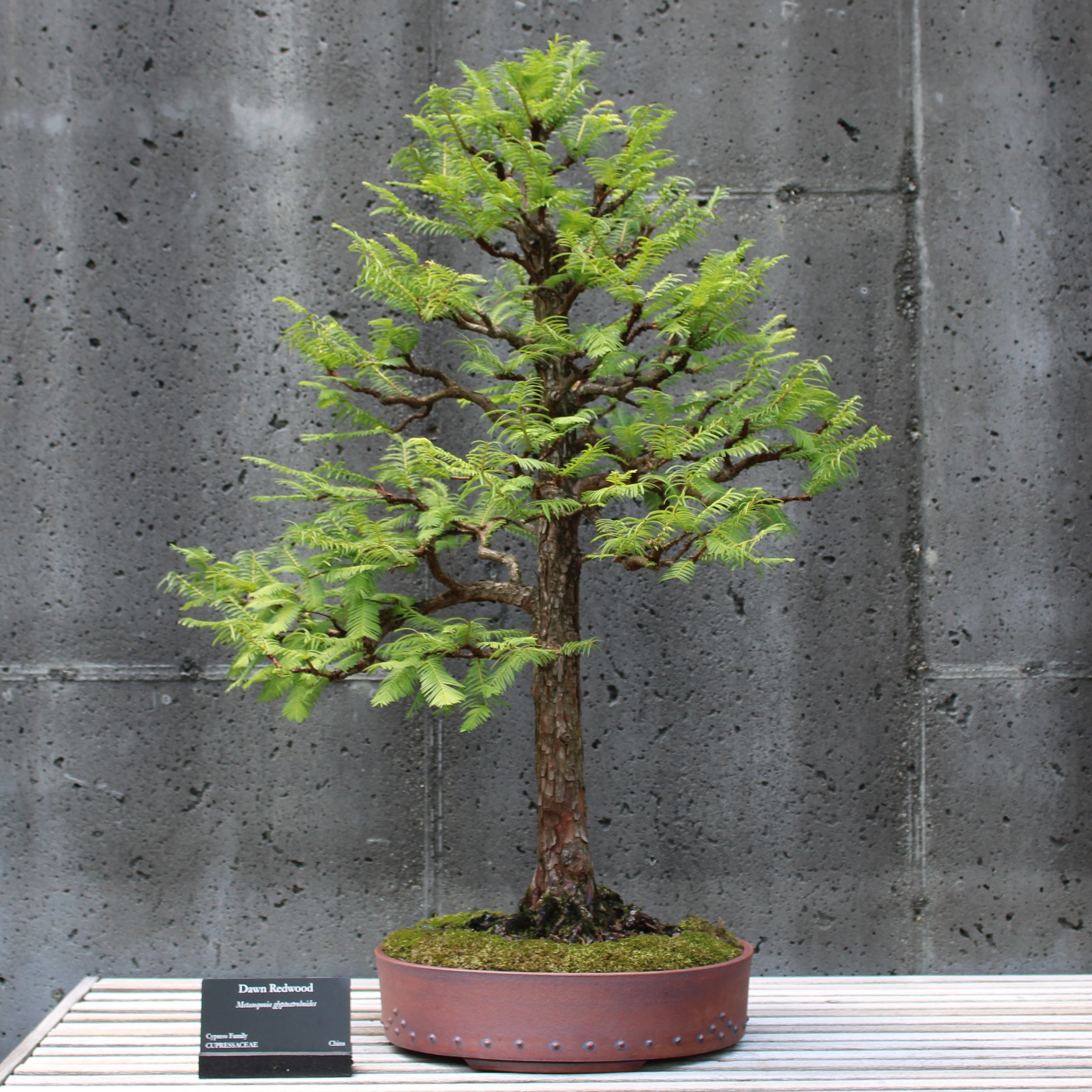Dawn Redwood
There are certain bonsai enhanced by some unique association attached to them. Whatever their appearance and however they may be judged aesthetically, bonsai of this sort have the essence of some greater identity due to particular circumstances. This something extra may be a remarkable story involving the individual bonsai itself, or, as is the case with our dawn redwood (Metasequoia glyptostroboides), the added interest may pertain to the species of plant from which the bonsai is made.
The genus Metasequoia was originally known to humankind only through the fossil record, which indicated trees of this group had lived more than one hundred fifty million years ago. All its members were thought to be extinct. Then in 1941 a small extant population of dawn redwood trees was discovered in a remote valley in central China. World War II was underway at the time, so any sort of scientific response to the discovery had to wait. But in 1947 the Arnold Arboretum of Harvard University funded an expedition to collect seed from the remaining population of dawn redwood trees, and this seed was distributed to horticultural institutions in China, Europe and the United States. Dawn redwood remains an endangered species in the wild, but the tree is doing better under cultivation and can be found in many places throughout the world.
This is a large, healthy dawn redwood landscape specimen at the Morris Arboretum in Pennsylvania:
The North Carolina Arboretum has a nice stand of dawn redwood that can be seen adjacent to the Recreation Parking lot, near the gatehouse:
The dawn redwood trees on the Arboretum property were planted by the US Forest Service in the 1950s as part of an early effort to establish an arboretum at Bent Creek. That effort was abandoned but a number of different trees planted then still survive on the site. The above image shows the dawn redwoods exhibiting autumn coloration, a feature they have as deciduous conifers.
It is not so likely that many visitors to the Arboretum know about the unique history of dawn redwood as a species, but some do. Others read the label next to our dawn redwood bonsai when it’s on display and see the name redwood, then mistakenly think what they are looking at is a bonsai version of the giant redwoods from California (Sequoiadendron giganteum). Dawn redwoods are distantly related to the famous big trees from the west coast of North America, but they are not the same. Still, I never correct any visitor who expresses delight at the idea of a giant redwood being made into a bonsai. Those largest of trees are sometimes made into bonsai, but we don't happen to have one. We have the other kind of redwood — the kind that is known as a living fossil.
Our dawn redwood bonsai came to us as a donation from Mr. Felix Laughlin in 2013. Felix is well known in bonsai circles for his many years of good work as president of the National Bonsai Foundation, the entity that supports and sustains the US National Bonsai and Penjing Museum in Washington, DC. Felix also served a four-year term as chairman of the World Bonsai Friendship Federation (WBFF). The WBFF promotes the idea of bonsai bringing people together, with the second Saturday of every May designated as World Bonsai Day. On that day bonsai people all over the world celebrate the ideal of World Peace Through Bonsai, which was first promulgated by Japanese bonsai master Suburu Kato in 1970. Felix is a believer in Mr. Kato's ideal and has worked tirelessly to advance it. Among his efforts was the establishment of a World Bonsai Day event at The North Carolina Arboretum, which led to the second Saturday of May becoming the official annual date for the return of the bonsai to the Arboretum's bonsai garden after the winter hiatus. Usually there are also other bonsai activities that day to celebrate the occasion.
On World Bonsai Day in 2013, part of the festivities at the Arboretum included a live demonstration that I presented to Members of The North Carolina Arboretum Society. The subject tree for the demonstration was a dawn redwood that belonged to Felix Laughlin. Only a few days prior I had paid a visit to Felix and was admiring his excellent personal bonsai collection. I took note of a tree I initially mistook as a baldcypress, only to be told by Felix that it was a dawn redwood, which he then informed me was something of a puzzle to him. The tree featured a straight trunk and was styled to be a formal upright bonsai, but it lacked definition and wanted for visual interest. I asked Felix if he would consider letting me work on his dawn redwood for my upcoming demonstration program. He consented. The following photo was made during that demonstration prior to any work being done on the tree:
At the conclusion of the demonstration, after expressing his satisfaction with the outcome, Felix asked if the Arboretum would consider taking the dawn redwood as a donation. I had thought we were only borrowing the tree, but Felix's generous offer sounded good to me. I thought it would be a fine thing for the Arboretum to have a living fossil in our bonsai collection.
Regrettably, there is no other photo-documentation of this specimen for the first five years we had it. During that time I was following up on and further refining the work begun in the 2013 demonstration program. Felix's dissatisfaction with the tree was that he did not find the look of it compelling. The formal upright is considered an elemental bonsai tree form, but the straight trunk that typifies the form is not dynamic. Much greater visual interest can be generated with a trunk that has movement. To create more interest with this specimen required removing sizable sections of the crown to break up its mass and then shaping the remaining branches into a more distinctive pattern. I thought the tree was also too tall, so as part of the demonstration the whole upper portion of the plant was removed. A new top was made by selecting a lateral branch and wiring it into an upright position to take over as a new leader. In subsequent years that new top had to be further developed so it would not look so obvious what had been done. These alterations were fairly subtle as bonsai styling goes, but still it took awhile for the tree to grow into its new look. The process was further slowed by my inexperience working with dawn redwood. I had to learn how to handle the material.
The following images were made in autumn of 2018. They show two different possible viewing angles, as well as the attractive autumn coloration of dawn redwood (click on either image for larger view):
In spring of 2020 our dawn redwood looked like this (click on either image for larger view):
This detail shows where the top of the tree had been removed in the 2013 demonstration and the progress that had been made since then toward building a new top:
The procedure of lowering the height of a bonsai by removing its apex is based on something that happens often enough in nature. The following image shows a red spruce (Picea rubens) in the mountains of western North Carolina that lost its top somehow and then grew a new one:
In 2022 our dawn redwood received a new container. The pot in which it arrived was a nice piece of Japanese tokoname-ware, but in the Arboretum's bonsai collection pottery of American manufacture is always preferable. The new pot was made by Robert Wallace, who chose to stay close to the aesthetic feeling of the previous pot when he designed his work. The little tree in its elegant new container was then displayed in the bonsai garden for the first time.
Here are two different presentations of the dawn redwood in summertime, 2022 (click on either image for larger view):
This is a view of the tree showing its autumn color later that same year:
Every spring this dawn redwood bonsai receives a detailed pruning and is then repotted. Here is how the tree shaped up this spring (click on either image for larger view):
A flush of fresh new foliage as another growing season begins:

















